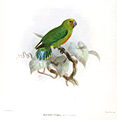Micropsitta keiensis




































Adult: M.k. keiensis: both adults mainly green; yellow crown, becoming dusky on forehead; brown face, changing to green on lower cheeks; yellow undertail coverts; blue central tail feathers; green/black lateral tail feathers. Bill grey. Eye brown. M.k. viridipectus: darker in general than keiensis; brown crown tinted with yellow. M.k. chloroxantha: male- orange/red centre of breast and abdomen, the remaining underparts yellow/green. Female- underparts all yellow/green; green/yellow crown. Colourization Juvenile: M.k. keiensis: in general duller in colour. Bill yellow tipped with grey/brown. M.k. viridipectus: as in adults. M.k. chloroxantha: as in adult female. Call: Calls are high-pitched and squeaky notes repeated at short spans.
Not Threatened.
Adult: M.k. keiensis: both adults mainly green; yellow crown, becoming dusky on forehead; brown face, changing to green on lower cheeks; yellow undertail coverts; blue central tail feathers; green/black lateral tail feathers. Bill grey. Eye brown. M.k. viridipectus: darker in general than keiensis; brown crown tinted with yellow. M.k. chloroxantha: male- orange/red centre of breast and abdomen, the remaining underparts yellow/green. Female- underparts all yellow/green; green/yellow crown. Colourization Juvenile: M.k. keiensis: in general duller in colour. Bill yellow tipped with grey/brown. M.k. viridipectus: as in adults. M.k. chloroxantha: as in adult female. Call: Calls are high-pitched and squeaky notes repeated at short spans.
Taxonomy:
- Nasiterna keiensis Salvadori, 1875, Kai Islands. Forms a superspecies with M. geelvinkiana and M. pusio. Three subspecies recognized. (source: Handbook of the Birds of World)
Subspecies and Distribution:
- * keiensis (Salvadori, 1875) - Kai Is and Aru Is. * chloroxantha Oberholser, 1917 - W Papuan Is, Vogelkop and Onin Peninsula, W Irian Jaya. * viridipectus (Rothschild, 1911) - S New Guinea.
Moist lowland forests, mangrove forests, and moist montanes.
The diet includes lichens, insects, fungi and mosses.
The Yellow-capped Pygmy Parrot is an arboreal termitaria nester. Two eggs are laid in the unlined cavity and are incubated by the female, and possibly up to four other roosting "helper" adults.



